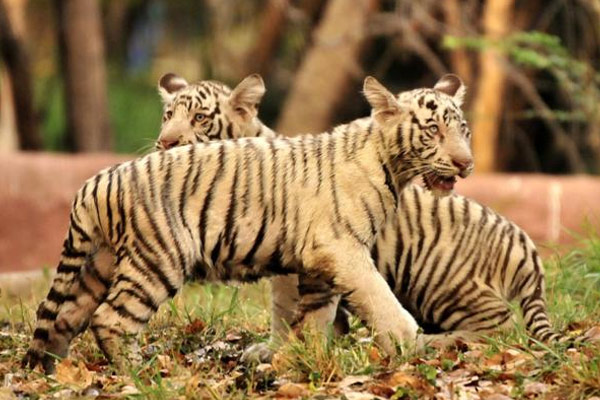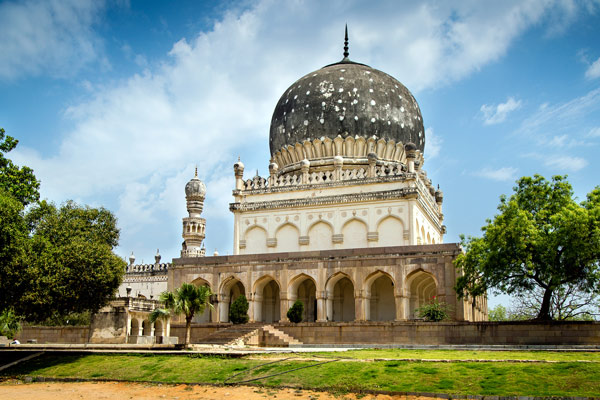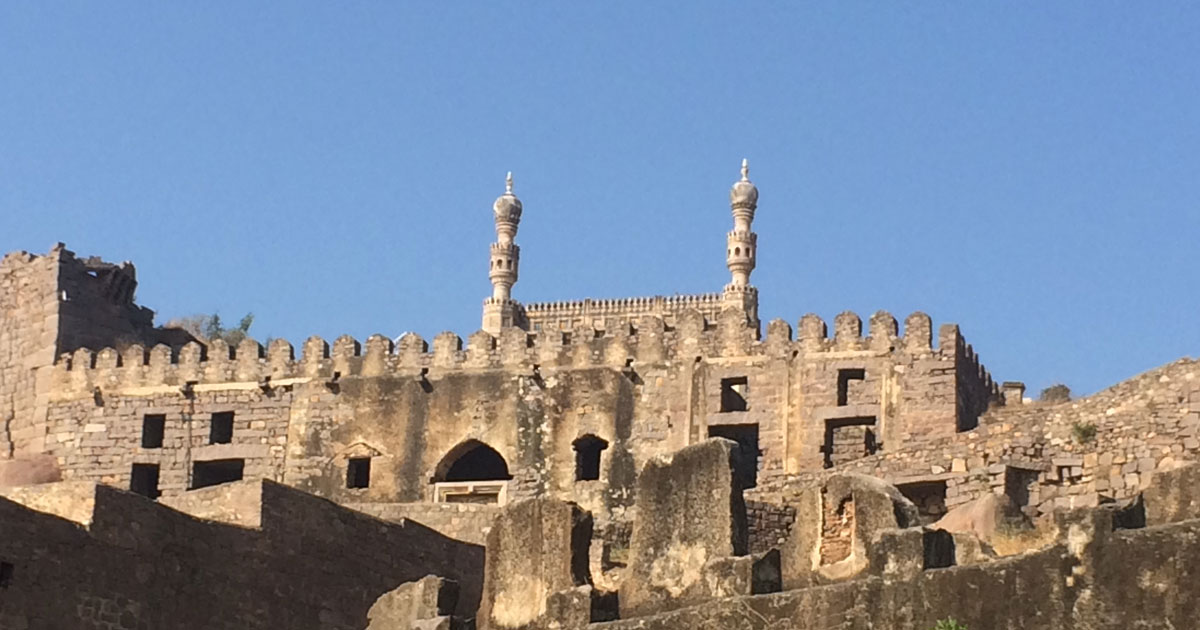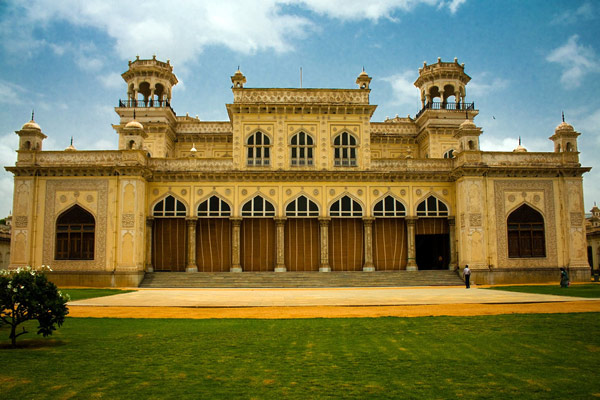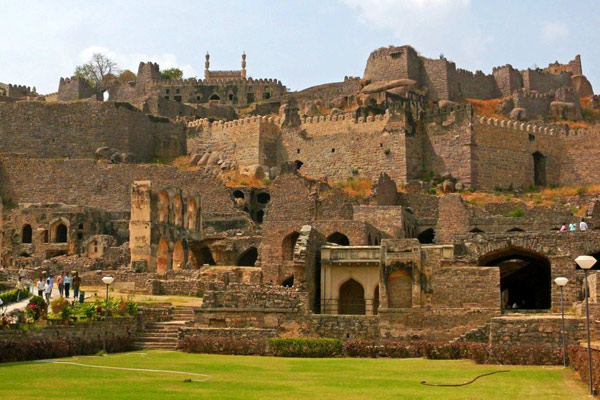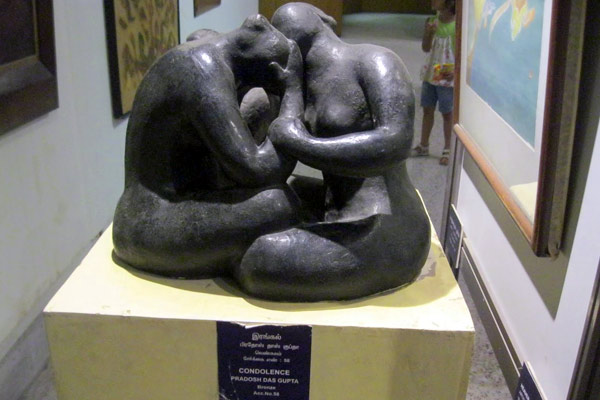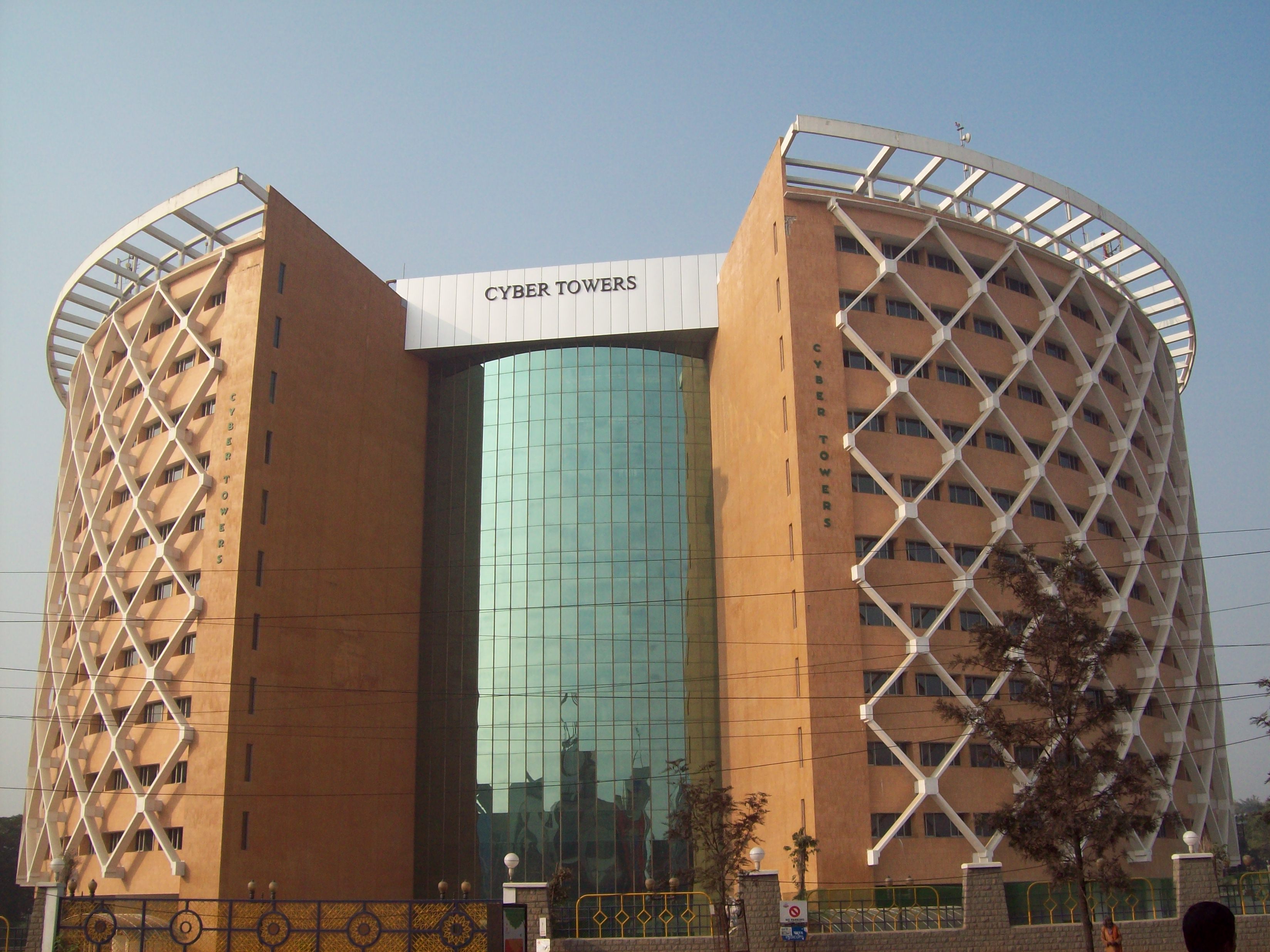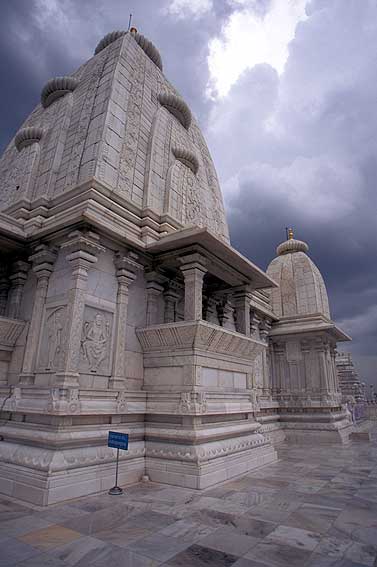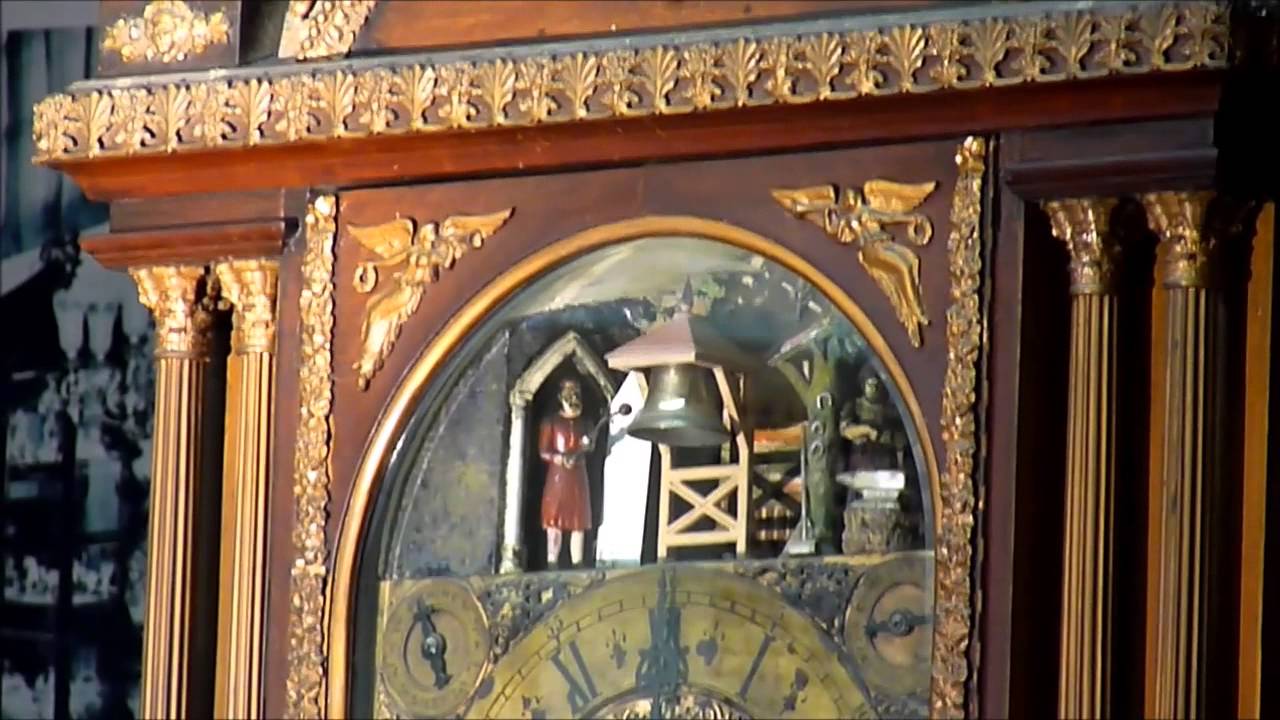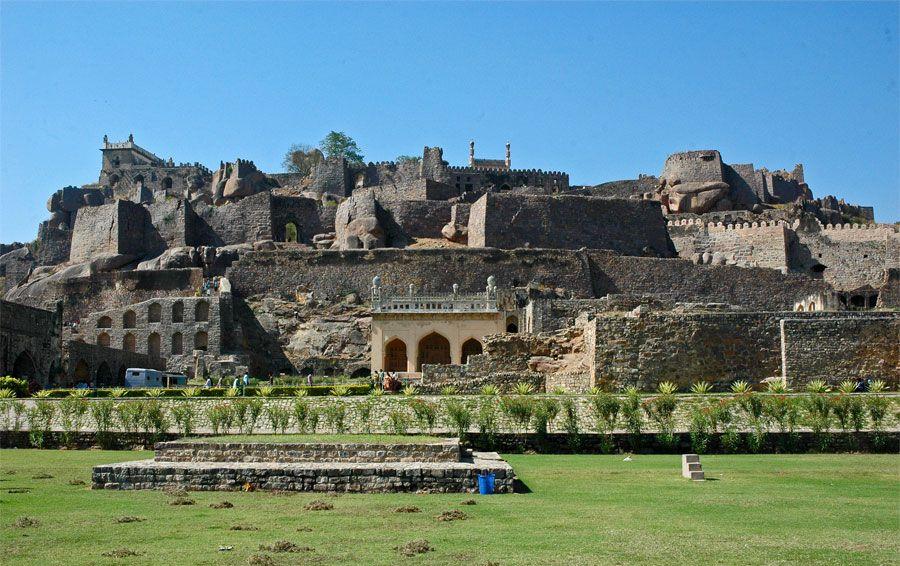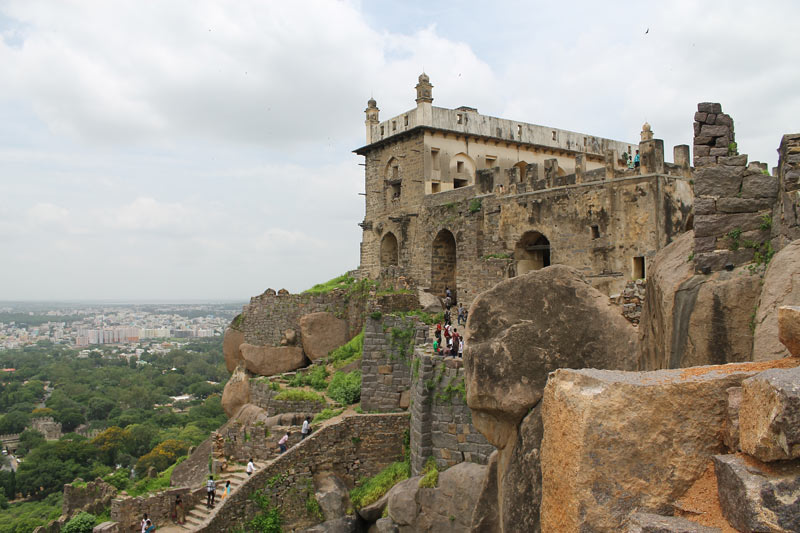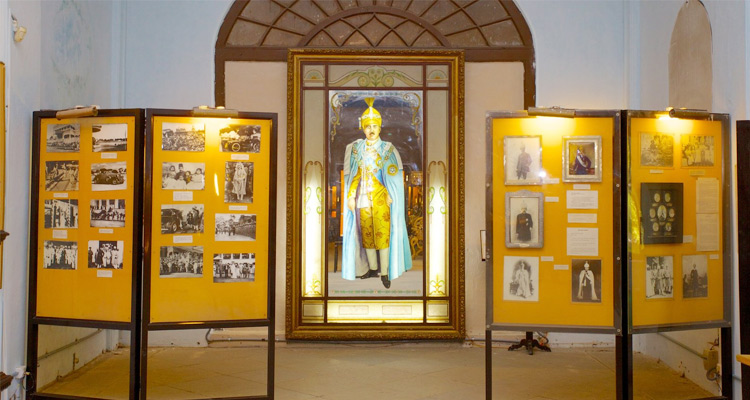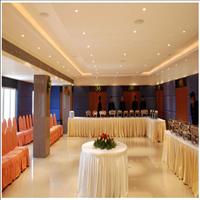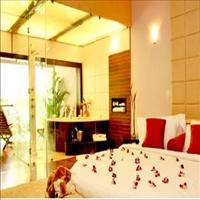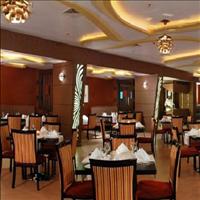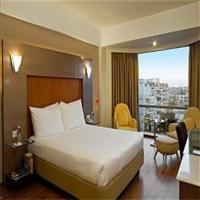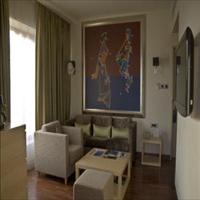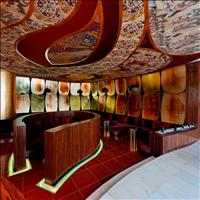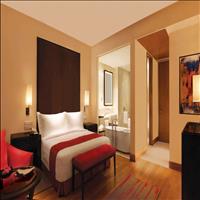Hyderabad
The Pearl City Of India
General Information
District: Hyderabad, State: Andhra Pradesh, India
Area: 217 Sq. Km.
Languages Spoken: Urdu, Telugu, Hindi and English
Long Distance Code: +91-40
Importance: Capital of Andhra Pradesh and city of Charminar.
Best Time to Visit: October to March
International Access: Rajiv Gandhi International Airport (Hyderabad)
Description
Hyderabad, the capital of Andhra Pradesh, INDIA, is the city of Love and Joy! Hyderabad city has lot of Charm, and the people who live here have an Intrinsic Goodness in them that touches one and all. Hyderabad is renowned for Hospitality, Hyderabadi Biryani and Irani Chai.<br />Hyderabad is a bustling 400-year-old metropolis with an urban population of 4.2 million people approximately. Hyderabad is located on the Deccan Plateau and the Musi River, 650m above sea level. Hills, tanks, forests, and rock formations dominate the physiography of Hyderabad.<br />The history of Hyderabad begins with the establishment of the Qutub Shahi dynasty. Quli Qutub Shah seized the reins of power from the Bahamani kingdom in 1512 and established the fortress city of Golconda. Inadequacy of water, and frequent epidemics of plaque and cholera persuaded Mohammad, the fifth Quli Qutub Shahi ruler to venture outward to establish the new city with the Charminar as its center and with four great roads fanning out in the four cardinal directions. Hyderabad's fame, strategic location and Golconda's legendary wealth attracted Aurangazeb who captured Golconda after a long siege in 1687. After this defeat the importance of Hyderabad declined and the city fell into partial ruin.<br />As the Mughal Empire decayed and began to disintegrate, the viceroy, Asaf Jah I proclaimed himself the Nizam and established independent rule of the Deccan. Hyderabad once again became a major capital city, ruled by successive Nizams of the Asaf Jah dynasty until the state was merged into the Indian Union in 1948.<br />Location
Located in the heart of the Deccan Plateau at an altitude of 1750 ft. above sea level, the twin cities of Hyderabad and Secunderabad are the economic hub of the state of Andhra Pradesh.
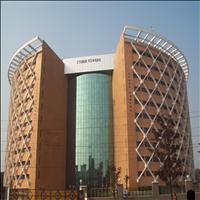 Standing in tough competition with the first cyber city of India, Bangalore, Hyderabad has built this Hitech city, the artistically and yet functionally built 10-storeyed cylindrical building surrounded by a galaxy of imposing structures raised to house IT companies. It is a city planned as an integrated township with all infrastructure facilities like office space, production areas housing colonies, showrooms, cafeteria, health club, banks, shopping complexes and auditoriums.
Standing in tough competition with the first cyber city of India, Bangalore, Hyderabad has built this Hitech city, the artistically and yet functionally built 10-storeyed cylindrical building surrounded by a galaxy of imposing structures raised to house IT companies. It is a city planned as an integrated township with all infrastructure facilities like office space, production areas housing colonies, showrooms, cafeteria, health club, banks, shopping complexes and auditoriums.Timings: abc
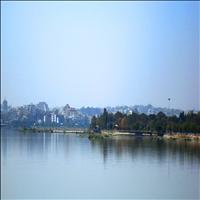 Constructed in the year 1562, the magnificent Hussain Sagar connects the twin cities of Hyderabad and Secunderabad. Subsequently, 33 statues of the regions historical figures were placed all along the bund that ran across the lake. The well laid out Lumbini Park in the Buddha Purnima Project has a musical fountain.\r\n \r\nBuddha Statue - Tank Bund\r\nFrom the midst of the calm clear waters of the Hussain Sagar emerges a 16m tall, 350 tonne statue of Lord Buddha. The statue of Lord Buddha is placed on a huge rock in the middle of the lake.\r\n
Constructed in the year 1562, the magnificent Hussain Sagar connects the twin cities of Hyderabad and Secunderabad. Subsequently, 33 statues of the regions historical figures were placed all along the bund that ran across the lake. The well laid out Lumbini Park in the Buddha Purnima Project has a musical fountain.\r\n \r\nBuddha Statue - Tank Bund\r\nFrom the midst of the calm clear waters of the Hussain Sagar emerges a 16m tall, 350 tonne statue of Lord Buddha. The statue of Lord Buddha is placed on a huge rock in the middle of the lake.\r\n One of the finest universities of India, architecturally as well as educationally, the Osmania University is the educational hub of Hyderabad.
One of the finest universities of India, architecturally as well as educationally, the Osmania University is the educational hub of Hyderabad. Built over a span of ten years, by a Birla Foundation, the Birla Mandir is a beautiful modern temple overlooking the south end of Hussain Sagar, providing an excellent view over the city from the summit. Dedicated to Lord Venkateshwara, there are intricate carvings in the temple and on the ceiling. This magnificent structure is a blend Of Orissan & South Indian Temple Art and is cosidred to be the best of all the Birla Temples constructed all over India.
Built over a span of ten years, by a Birla Foundation, the Birla Mandir is a beautiful modern temple overlooking the south end of Hussain Sagar, providing an excellent view over the city from the summit. Dedicated to Lord Venkateshwara, there are intricate carvings in the temple and on the ceiling. This magnificent structure is a blend Of Orissan & South Indian Temple Art and is cosidred to be the best of all the Birla Temples constructed all over India.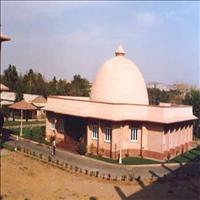 The first of its kind in the country and the most modern in India, the Birla Planetarium is built on Naubatpahad, and is equipped with the most advanced technology from Japan. Nearby, the Birla Science Museum pays tribute to the advances made in science and technology since the beginning of civilisation.
The first of its kind in the country and the most modern in India, the Birla Planetarium is built on Naubatpahad, and is equipped with the most advanced technology from Japan. Nearby, the Birla Science Museum pays tribute to the advances made in science and technology since the beginning of civilisation.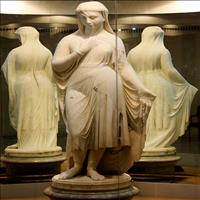 One of the finest one man collections in the world, the Salarjung Museum has over 40,000 objects on display. It was the personal collection of the Prime Minister to the Nizam, Mir Yusuf Ali Khan, also known as Salrjung III, which has the best collection today. Mir had a passion for collecting things and he spent most of his money and his entire life towards collecting the art objects, rare manuscripts and paintings from all over the world. There are various galleries dedicated to particular objects from all over the world, but the most famous of all is the clock gallery which has clocks chiming and gonging and some interesting, most of which are in perfect condition. \r\n
One of the finest one man collections in the world, the Salarjung Museum has over 40,000 objects on display. It was the personal collection of the Prime Minister to the Nizam, Mir Yusuf Ali Khan, also known as Salrjung III, which has the best collection today. Mir had a passion for collecting things and he spent most of his money and his entire life towards collecting the art objects, rare manuscripts and paintings from all over the world. There are various galleries dedicated to particular objects from all over the world, but the most famous of all is the clock gallery which has clocks chiming and gonging and some interesting, most of which are in perfect condition. \r\nClosed On: Friday
Timings: 10:00 AM to 5:00 PM
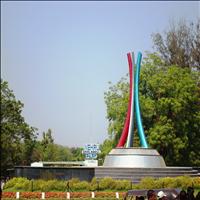 One of the largest and the best zoos in Asia, the Nehru Zoological Park has nearly 1,500 species of animals, birds and reptiles. Situated in the Bahadurpura area on the way to the N G Ranga Agricultural University in Rajendranagar, the zoo is ahead of Afzalgunj, the Osmania General Hospital and the High Court of AP.\r\nThe popular ones among the different species are white peacocks, mynahs, chimpanzees and rhinoceros. The major attraction within the zoo, however, is the Lion Safari. A van barbed with wrought iron takes you through the gates of the safari opening one gate at a time into a completely different world of wild animals where lions, tigers, rhinos, wild oxen, panthers, etc. are left freely in the wilderness of a simulated jungle.\r\nApart from the animals, a nocturnal zoo, the pre-historic dinosaur park, a natural history museum, parks, a mini-train and animal rides make the place ideal for a picnic. The nocturnal animals and the reptiles form a particularly interesting part of the whole. A must visit for all those who can walk around for 6-7 hours to cover the entire zoo which is on 300 acres of land.
One of the largest and the best zoos in Asia, the Nehru Zoological Park has nearly 1,500 species of animals, birds and reptiles. Situated in the Bahadurpura area on the way to the N G Ranga Agricultural University in Rajendranagar, the zoo is ahead of Afzalgunj, the Osmania General Hospital and the High Court of AP.\r\nThe popular ones among the different species are white peacocks, mynahs, chimpanzees and rhinoceros. The major attraction within the zoo, however, is the Lion Safari. A van barbed with wrought iron takes you through the gates of the safari opening one gate at a time into a completely different world of wild animals where lions, tigers, rhinos, wild oxen, panthers, etc. are left freely in the wilderness of a simulated jungle.\r\nApart from the animals, a nocturnal zoo, the pre-historic dinosaur park, a natural history museum, parks, a mini-train and animal rides make the place ideal for a picnic. The nocturnal animals and the reptiles form a particularly interesting part of the whole. A must visit for all those who can walk around for 6-7 hours to cover the entire zoo which is on 300 acres of land.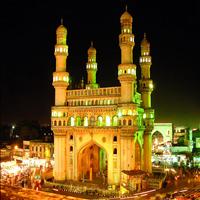 It is a magnificent square edifice of granite, built upon four grand arches facing North, South, East and West. These arches support two floors of rooms and gallery of archways. At each corner of the square structure is a minaret rising to a height of 24 meters, making the building nearly 54 meters tall. It is these four (char) minarets (minar) that give the building, its name ‘Charminar’. Each minar stands on a lotus-leaf base, a special recurrent motif in Qutub Shahi buildings.\r\nThe first floor was used as a madarasa (college) during the Qutub Shahi period. The second floor has a mosque on the western side, the dome of which is visible from the road, if one stands some distance away. A spectacular view of the city may be had from the roof of the Charminar, although, due to severe overcrowding of the minarets, only visitors with special permission from the Archaeological Survey of India, Hyderabad Circle are allowed to go to the top of the minarets. The clocks above each of the four archways were added in 1889.\r\nTimings: people are allowed (only in the cellar of the monument) all the day and during night times till 10 o clock.
It is a magnificent square edifice of granite, built upon four grand arches facing North, South, East and West. These arches support two floors of rooms and gallery of archways. At each corner of the square structure is a minaret rising to a height of 24 meters, making the building nearly 54 meters tall. It is these four (char) minarets (minar) that give the building, its name ‘Charminar’. Each minar stands on a lotus-leaf base, a special recurrent motif in Qutub Shahi buildings.\r\nThe first floor was used as a madarasa (college) during the Qutub Shahi period. The second floor has a mosque on the western side, the dome of which is visible from the road, if one stands some distance away. A spectacular view of the city may be had from the roof of the Charminar, although, due to severe overcrowding of the minarets, only visitors with special permission from the Archaeological Survey of India, Hyderabad Circle are allowed to go to the top of the minarets. The clocks above each of the four archways were added in 1889.\r\nTimings: people are allowed (only in the cellar of the monument) all the day and during night times till 10 o clock.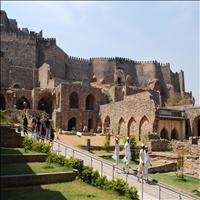 Founded originally by the Kakatiyas in the year 1140, Golconda was expanded by the Qutub Shahi kings into a massive fort of granite with walls and ramparts extending to a length of 5km in circumference. Kakatiya kings built this fort. From this fort they ruled the nearby areas even when their capital was based in Warangal. This massive fort is 11 km in perimeter and its walls are 15 to 18 ft high. The whole fort is built in granite and is flanked by 70 ramparts and 8 huge gates. Previously the whole fort was surrounded by a deep gorge but slowly this was filled up. While entering from the main gate of the fort, if one claps below the Grand Portico, echoes are heard in a Darbar hall some 128 meters away.\r\nThe fortress city within the walls was famous for the diamond trade and is said to been the origin of the famous Koh-i-noor diamond. The historic fort lays 11km west of the city of Hyderabad. The name originates from the Telugu words "Golla" meaning Shepard and "Konda" or hill - The 'shepherd's hill'. The fort was later taken over by the Bahamani kings, subsequently passing into the hands of the Qutub Shahis, who held it from 1512 to 1687 AD. The first three Qutub Shahi kings rebuilt Golconda over a span of 62 years.\r\nFamous features of Golconda include its system of acoustics, palaces, factories, the water supply system. The famous Rahban cannon was used during the last seize of Golconda by Aurangazeb to whom the fort ultimately fell.
Founded originally by the Kakatiyas in the year 1140, Golconda was expanded by the Qutub Shahi kings into a massive fort of granite with walls and ramparts extending to a length of 5km in circumference. Kakatiya kings built this fort. From this fort they ruled the nearby areas even when their capital was based in Warangal. This massive fort is 11 km in perimeter and its walls are 15 to 18 ft high. The whole fort is built in granite and is flanked by 70 ramparts and 8 huge gates. Previously the whole fort was surrounded by a deep gorge but slowly this was filled up. While entering from the main gate of the fort, if one claps below the Grand Portico, echoes are heard in a Darbar hall some 128 meters away.\r\nThe fortress city within the walls was famous for the diamond trade and is said to been the origin of the famous Koh-i-noor diamond. The historic fort lays 11km west of the city of Hyderabad. The name originates from the Telugu words "Golla" meaning Shepard and "Konda" or hill - The 'shepherd's hill'. The fort was later taken over by the Bahamani kings, subsequently passing into the hands of the Qutub Shahis, who held it from 1512 to 1687 AD. The first three Qutub Shahi kings rebuilt Golconda over a span of 62 years.\r\nFamous features of Golconda include its system of acoustics, palaces, factories, the water supply system. The famous Rahban cannon was used during the last seize of Golconda by Aurangazeb to whom the fort ultimately fell.Closed On: Monday
Timings: 09.00 am - 5.00 pm
Remarks: Hyderabad (Golconda)
 A little away from Golconda fort are a cluster of tombs, the most authentic evidence of the Qutub Shahi architectural traditions. Ensconced amidst picturesque and landscaped gardens, known as Ibrahim bagh, is the grandeur of these tombs dedicated to the memory of the seven Qutub Shahi kings who ruled Golconda for nearly 170 years. These constitute the most eloquent specimens of Indo-Persian architecture influenced by Deccani structural perceptions. The total impact of this fusion is the emergence of a distinct Qutub Shahi school marked by ostentation of arches, domes, minarets and columns. These architectural tendencies began surfacing in the time of Ibrahim Qutub Shah and reached their climax in the reign of Muhammad Quli Qutub Shah. The tombs are also an unequivocal manifestation of the structural engineering talent of the Qutub Shahi period.
A little away from Golconda fort are a cluster of tombs, the most authentic evidence of the Qutub Shahi architectural traditions. Ensconced amidst picturesque and landscaped gardens, known as Ibrahim bagh, is the grandeur of these tombs dedicated to the memory of the seven Qutub Shahi kings who ruled Golconda for nearly 170 years. These constitute the most eloquent specimens of Indo-Persian architecture influenced by Deccani structural perceptions. The total impact of this fusion is the emergence of a distinct Qutub Shahi school marked by ostentation of arches, domes, minarets and columns. These architectural tendencies began surfacing in the time of Ibrahim Qutub Shah and reached their climax in the reign of Muhammad Quli Qutub Shah. The tombs are also an unequivocal manifestation of the structural engineering talent of the Qutub Shahi period.Closed On: Friday
Timings: 9:30 AM To 6:30 PM
 The city of Hyderabad is replete with imposing monuments, which give a clue to the rich historical background of the land. It also boasts of the magnificent palaces like the Falaknuma palace, the Chowmohalla palace and the Purani Haveli. Among these, the Falaknuma palace is a remarkable edifice, which stands atop a 200 feet high hillock. It is located 5 km from Charminar. Built by Nawab Vikar-Ul-Ulmara, the Prime Minister of Hyderabad, it is a stupendous palace and connotes the "heavenly abode".\r\nIt is believed that the Falaknuma palace was gifted to the sixth Nizam of Hyderabad, Mehboob Ali Khan by the generous Nawab. The palace was constructed over a period of seven years and it covers a total area of 9,39,712 square meters.\r\nA majesty testimony to the glory of the Nizams, it stands atop a hill 2000 feet high. It has often been referred to as the 'Mirror of the Sky'. The palace was designed by a Italian architect and follows a western architectural style. Falaknuma houses a large collection of rare treasures collected by the Nizam including paintings, statues, furniture, manuscripts and books
The city of Hyderabad is replete with imposing monuments, which give a clue to the rich historical background of the land. It also boasts of the magnificent palaces like the Falaknuma palace, the Chowmohalla palace and the Purani Haveli. Among these, the Falaknuma palace is a remarkable edifice, which stands atop a 200 feet high hillock. It is located 5 km from Charminar. Built by Nawab Vikar-Ul-Ulmara, the Prime Minister of Hyderabad, it is a stupendous palace and connotes the "heavenly abode".\r\nIt is believed that the Falaknuma palace was gifted to the sixth Nizam of Hyderabad, Mehboob Ali Khan by the generous Nawab. The palace was constructed over a period of seven years and it covers a total area of 9,39,712 square meters.\r\nA majesty testimony to the glory of the Nizams, it stands atop a hill 2000 feet high. It has often been referred to as the 'Mirror of the Sky'. The palace was designed by a Italian architect and follows a western architectural style. Falaknuma houses a large collection of rare treasures collected by the Nizam including paintings, statues, furniture, manuscripts and books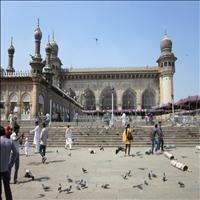 Near the Charminar stands the Mecca Masjid, begun by Muhammad Qutb Shah in 1617 and completed by Quranzeb in 1693. It is a grand edifice with a huge courtyard, which can accommodate nearly ten thousand men at prayer. Tavernier has provided a graphic description of the mammoth boulders cut to size and carted for use in the building of the mosque. The minarets look rather stunted in comparison with the grandeur of the whole massive structure. But it looks more Mughal then Qutb Shahi in its perfect granite finish and vast courtyard. A particular stone brick in the mihrab is believed that to have been brought from Mecca.\r\nThe other two mosques—-the Jami Masjid and the Toli Masjid—are small and modest structures. Muhammad Quli Shah built the Jami Masjid in 1592, after founding Hyderabad. Musa Khan, a supervisor of works at the Mecca Masjid, levied a damri for every rupee spent on the building of the Mecca Masjid. With these collections he built the Toli Masjid, near the Purana Pul. Two buildings, the Badshahi Ashur Khana and Darul Shifa—built in 1594—are much dilapidated and in need of large scale repair.
Near the Charminar stands the Mecca Masjid, begun by Muhammad Qutb Shah in 1617 and completed by Quranzeb in 1693. It is a grand edifice with a huge courtyard, which can accommodate nearly ten thousand men at prayer. Tavernier has provided a graphic description of the mammoth boulders cut to size and carted for use in the building of the mosque. The minarets look rather stunted in comparison with the grandeur of the whole massive structure. But it looks more Mughal then Qutb Shahi in its perfect granite finish and vast courtyard. A particular stone brick in the mihrab is believed that to have been brought from Mecca.\r\nThe other two mosques—-the Jami Masjid and the Toli Masjid—are small and modest structures. Muhammad Quli Shah built the Jami Masjid in 1592, after founding Hyderabad. Musa Khan, a supervisor of works at the Mecca Masjid, levied a damri for every rupee spent on the building of the Mecca Masjid. With these collections he built the Toli Masjid, near the Purana Pul. Two buildings, the Badshahi Ashur Khana and Darul Shifa—built in 1594—are much dilapidated and in need of large scale repair. The Lad Bazaar is the heart of the Muslim part of Hyderabad City and has attractive buildings with wood and stone carvings and pink elephant gates. The area is considerably crowded and getting glimpse of these structures may be difficult.\r\nThe chowk or cross roads close by has a mosque and a Victorian Clock Tower. The Chaumahalla Palace, built around a quadrangle, which is amongst the large number of palaces built by various Nizams in the same complex, lies to the southeast of the Lad Bazaar.
The Lad Bazaar is the heart of the Muslim part of Hyderabad City and has attractive buildings with wood and stone carvings and pink elephant gates. The area is considerably crowded and getting glimpse of these structures may be difficult.\r\nThe chowk or cross roads close by has a mosque and a Victorian Clock Tower. The Chaumahalla Palace, built around a quadrangle, which is amongst the large number of palaces built by various Nizams in the same complex, lies to the southeast of the Lad Bazaar. One of the most comprehensive and planned film city in the world, the Ramoji film city is conviniently located in the outskirts of Hyderabad at a distance of 2 hours. This well planned city has a everything that making of a movie can need, from waterfalls to lakes and form hospitals to schools. There are skyscrapers and bungalows and buses and also interior of a huge jumbo jet. A temple a church, a mosque, with well laid gardens and artficially costructed villages, the film city is a created paradise. Spread over an area of 1000 acres of land, the film city is owned by enterpreneur and film producer Ramoji Rao. Shootings of various films and advertisements take place here.
One of the most comprehensive and planned film city in the world, the Ramoji film city is conviniently located in the outskirts of Hyderabad at a distance of 2 hours. This well planned city has a everything that making of a movie can need, from waterfalls to lakes and form hospitals to schools. There are skyscrapers and bungalows and buses and also interior of a huge jumbo jet. A temple a church, a mosque, with well laid gardens and artficially costructed villages, the film city is a created paradise. Spread over an area of 1000 acres of land, the film city is owned by enterpreneur and film producer Ramoji Rao. Shootings of various films and advertisements take place here.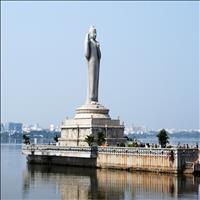 he great stupa or Mahachaitya at Amaravati was one of the biggest in Andhra Pradesh with a probable diameter of 50 meters and a height of 27 meters. It has a brick built circular vedika or drum with projecting rectangular Ayaka platforms in four cardinal directions measuring 7.20 X 2.10 meters each. Five Ayaka pillars must have stood on each platform symbolically representing the five main events in Buddha’s life viz., the birth, the great renunciation, the enlightenment, the first sermon and the final extinction. The drum and Ayaka platforms were covered with sculptured slabs. All the four-ayaka platforms have yielded seven crystal and one Ivory relic caskets, some of which contain bone-pieces, pearls, precious stones and gold flowers. This is a Sariraka type of stupa and hence it’s great importance.Mounted on this circular drum stood an anda or hemispherical dome. Tall sculptured dome slabs covered the vertical part of the dome, above which came decorations in stucco. Scenes from the life of Buddha, Jataka stories, animal motifs, floral decorations formed the subject matter of these sculptures carved on the locally available light green limestone.The drum was crowned by a harmika or box like structure over which stood a chhatra or umbrella. All now missing except the remains of the plinth.The drum of the stupa had a well laid Pradakshinapatha or circumambulatory path of 4 meters width paved with Cuddapah slabs protected by a railing in stone on its outer extreme end, pierced on all the four sides by gateways projecting out. The railing consisted of Urdhvapatas or Upright pillars, three suchis or cross-bars connecting each pair of upright pillars, and Ushnisha or coping stone running on top of those pillars. Seated lions stood on pillars guarding either side of the gateways. The stone railing of later periods was highly ornamental.The history of Mahachaitya is spread to a period of roughly over a thousand and seven hundred years (circa 3rd century. B.C to circa 14th century A.D). The foundation of this Maha-stupa must have been laid by the great Mahadeva-Bikshu emissary of Emperor Ashoka who was deputed to Mahishamandala for the propagation of the Buddhist norm. The first construction is believed to have been plain and modest.The ornamental renovations were brought later during the next seven centuries. The stupa had received its rich patronage from seven centuries. The stupa had received its rich patronage from Kings like Vasistiputra Pulumavi, Sivaskanda Statakarni, Gautamiputra Yajna Sri Satakarni, Buddhist monks like Acharya Nagarjuna, nuns like Nanda and lay-Devotees like Utara, Khalata etc. Evidence shows that the stupa was an object of worship receiving attention during the reign of the dynasties of the Satavahana, Ikshvaku, Chalukya, Pallava, Salankayana. Vishnukundin, Kakatiya and Kota kings. The Chinese traveler Yuan Chwang and the Tibetan Historian Taranath glorified in their accounts the greatness of this ancient seat of Buddhism.Colonel Colin Mackenzie of the Trignometrical survey had discovered these remains of the stupa in 1797. Subsequently Archaeologists like Mr.Burgess, Sri T.N.Ramachandran, Mr.Rea, Dr.R.Subrahmanyam, Dr.K.Krishna Murthi and Dr.I.Karathikeya Sarma have worked on it. Out of the vast sculptural wealth this stupa has yielded, a good number have become the objects of exhibition in the galleries of the British Museum, London, Musie Guimet, Germany, National Museum, New Delhi, Indian Museum Calcutta, Government Museum Madras. The rest are on display in the site museum.
he great stupa or Mahachaitya at Amaravati was one of the biggest in Andhra Pradesh with a probable diameter of 50 meters and a height of 27 meters. It has a brick built circular vedika or drum with projecting rectangular Ayaka platforms in four cardinal directions measuring 7.20 X 2.10 meters each. Five Ayaka pillars must have stood on each platform symbolically representing the five main events in Buddha’s life viz., the birth, the great renunciation, the enlightenment, the first sermon and the final extinction. The drum and Ayaka platforms were covered with sculptured slabs. All the four-ayaka platforms have yielded seven crystal and one Ivory relic caskets, some of which contain bone-pieces, pearls, precious stones and gold flowers. This is a Sariraka type of stupa and hence it’s great importance.Mounted on this circular drum stood an anda or hemispherical dome. Tall sculptured dome slabs covered the vertical part of the dome, above which came decorations in stucco. Scenes from the life of Buddha, Jataka stories, animal motifs, floral decorations formed the subject matter of these sculptures carved on the locally available light green limestone.The drum was crowned by a harmika or box like structure over which stood a chhatra or umbrella. All now missing except the remains of the plinth.The drum of the stupa had a well laid Pradakshinapatha or circumambulatory path of 4 meters width paved with Cuddapah slabs protected by a railing in stone on its outer extreme end, pierced on all the four sides by gateways projecting out. The railing consisted of Urdhvapatas or Upright pillars, three suchis or cross-bars connecting each pair of upright pillars, and Ushnisha or coping stone running on top of those pillars. Seated lions stood on pillars guarding either side of the gateways. The stone railing of later periods was highly ornamental.The history of Mahachaitya is spread to a period of roughly over a thousand and seven hundred years (circa 3rd century. B.C to circa 14th century A.D). The foundation of this Maha-stupa must have been laid by the great Mahadeva-Bikshu emissary of Emperor Ashoka who was deputed to Mahishamandala for the propagation of the Buddhist norm. The first construction is believed to have been plain and modest.The ornamental renovations were brought later during the next seven centuries. The stupa had received its rich patronage from seven centuries. The stupa had received its rich patronage from Kings like Vasistiputra Pulumavi, Sivaskanda Statakarni, Gautamiputra Yajna Sri Satakarni, Buddhist monks like Acharya Nagarjuna, nuns like Nanda and lay-Devotees like Utara, Khalata etc. Evidence shows that the stupa was an object of worship receiving attention during the reign of the dynasties of the Satavahana, Ikshvaku, Chalukya, Pallava, Salankayana. Vishnukundin, Kakatiya and Kota kings. The Chinese traveler Yuan Chwang and the Tibetan Historian Taranath glorified in their accounts the greatness of this ancient seat of Buddhism.Colonel Colin Mackenzie of the Trignometrical survey had discovered these remains of the stupa in 1797. Subsequently Archaeologists like Mr.Burgess, Sri T.N.Ramachandran, Mr.Rea, Dr.R.Subrahmanyam, Dr.K.Krishna Murthi and Dr.I.Karathikeya Sarma have worked on it. Out of the vast sculptural wealth this stupa has yielded, a good number have become the objects of exhibition in the galleries of the British Museum, London, Musie Guimet, Germany, National Museum, New Delhi, Indian Museum Calcutta, Government Museum Madras. The rest are on display in the site museum.Closed On: Friday
 Golconda (sometimes spelled as Golkonda) Fort was the capital of the ancient kingdom of Golconda which flourished in the 14th to 16th century. It is situated 11 kilometers from Hyderabad, the capital of the state of Andhra Pradesh. With walls ranging from 17 to 34 feet broken by 87 semi-circular bastions, some reaching 60 feet in height, and built on a granite hill that is 400 feet high, it remains one of India’s most magnificent fortress complexes.
Golconda (sometimes spelled as Golkonda) Fort was the capital of the ancient kingdom of Golconda which flourished in the 14th to 16th century. It is situated 11 kilometers from Hyderabad, the capital of the state of Andhra Pradesh. With walls ranging from 17 to 34 feet broken by 87 semi-circular bastions, some reaching 60 feet in height, and built on a granite hill that is 400 feet high, it remains one of India’s most magnificent fortress complexes.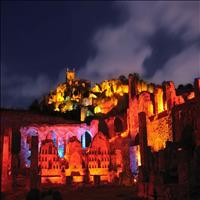 One of the most popular attractions on the tourists' list in Hyderabad -- the sound and light show at Golconda fort -- is losing its sheen.Scores of tourists who come to this monument ensure that they don't miss the sound and light show that narrates the history of the fort.
One of the most popular attractions on the tourists' list in Hyderabad -- the sound and light show at Golconda fort -- is losing its sheen.Scores of tourists who come to this monument ensure that they don't miss the sound and light show that narrates the history of the fort. The Salar Jung Museum was established in 1951. The major portion of the collection of the museum was acquired by Mir Yousuf Ali Khan, popularly known as Salar Jung III. In the absence of any direct descendants of Salar Jung III, the Government of India appointed a Committee to administer the Salar Jung Estate. Later on with the idea of perpetuating his name, the Salar Jung Museum was brought into existence on 16th December, 1951 in Diwan Deodi, the residential palace of Salar Jung III and opened to the public by Pandit Jawarharlal Nehru, the then Prime Minister of India. In 1958, the Government of India took over the museum through a compromise deed. Till 1958 this museum was administered by the Salar Jung Estate Committee. Thereafter the Museum continued to be administered by the Ministry of Scientific Research and Cultural Affairs, Government of India till 1961. In 1961, through an Act of Parliament, the Salar Jung Museum along with its library was declared as an “Institution of National Importance”.
The Salar Jung Museum was established in 1951. The major portion of the collection of the museum was acquired by Mir Yousuf Ali Khan, popularly known as Salar Jung III. In the absence of any direct descendants of Salar Jung III, the Government of India appointed a Committee to administer the Salar Jung Estate. Later on with the idea of perpetuating his name, the Salar Jung Museum was brought into existence on 16th December, 1951 in Diwan Deodi, the residential palace of Salar Jung III and opened to the public by Pandit Jawarharlal Nehru, the then Prime Minister of India. In 1958, the Government of India took over the museum through a compromise deed. Till 1958 this museum was administered by the Salar Jung Estate Committee. Thereafter the Museum continued to be administered by the Ministry of Scientific Research and Cultural Affairs, Government of India till 1961. In 1961, through an Act of Parliament, the Salar Jung Museum along with its library was declared as an “Institution of National Importance”.Closed On: Friday
Karnataka With Wildlife & Beach In Goa / PI-0256 (14 Days / 13 Nights)
Hyderabad-Bidar-Gulbarga-Bijapur-Badami-Pattadakal-Hospet-Hampi-Hospet-Dandeli-Goa-Mumbai
Stretching from the evergreen forests of Western ghats to the scrub jungle of plains, this trip takes you across the picturesque state of Karnataka. The forest reserves of the state are then followed by the relaxing sandy beaches of Goa where you can unwind in the tranquil setting of calm beaches and beautiful resorts.
Detailed Itinerary
Day 1 : Hyderabad
Day 2 : Hyderabad
Day 3 : Hyderabad-Bidar-Gulbarga
Day 4 : Gulbarga - Bijapur
Day 5 : Bijapur - Badami
Day 6 : Badami-Pattadakal-Hospet
Day 7 : Hospet-Hampi-Hospet
Day 8 : Hospet-Dandeli
Day 9 : Dandeli
Day 10 : Dandeli - Goa
Day 11 : Goa
Day 12 : Goa
Day 13 : Goa - Mumbai
Day 14 : Mumbai
Hyderabad-Bidar-Gulbarga-Bijapur-Badami-Pattadakal-Hospet-Hampi-Hospet-Dandeli-Goa-Mumbai
Stretching from the evergreen forests of Western ghats to the scrub jungle of plains, this trip takes you across the picturesque state of Karnataka. The forest reserves of the state are then followed by the relaxing sandy beaches of Goa where you can unwind in the tranquil setting of calm beaches and beautiful resorts.
Detailed Itinerary
Day 1 : Hyderabad
Day 2 : Hyderabad
Day 3 : Hyderabad-Bidar-Gulbarga
Day 4 : Gulbarga - Bijapur
Day 5 : Bijapur - Badami
Day 6 : Badami-Pattadakal-Hospet
Day 7 : Hospet-Hampi-Hospet
Day 8 : Hospet-Dandeli
Day 9 : Dandeli
Day 10 : Dandeli - Goa
Day 11 : Goa
Day 12 : Goa
Day 13 : Goa - Mumbai
Day 14 : Mumbai
Karnataka With Buddhist Tour / PI-0269 (15 Days / 14 Nights)
Mumbai-Aurangabad-Mumbai-Hyderabad-Gulbarga-Bijapur-Badami-Hospet-Hassan-Mysore-Bengaluru
This Buddhist tour of Karnataka takes you across the several Buddhist pilgrimage sites of the state that are considered to be important historical pieces of Indian history too. Starting from Aurangabad, the tour takes you across the scenic cities of Gulbarga, Bijapur, Badami, Hospet, the palace city of Mysore and finally ending with the fast moving yet laid back city of Bengaluru.
Detailed Itinerary
Day 1 : Mumbai
Day 2 : Mumbai
Day 3 : Mumbai - Aurangabad
Day 4 : Aurangabad - Mumbai
Day 5 : Mumbai-Hyderabad
Day 6 : Hyderabad - Gulbarga
Day 7 : Gulbarga - Bijapur
Day 8 : Bijapur - Badami
Day 9 : Badami - Hospet
Day 10 : Hospet
Day 11 : Hospet - Hassan
Day 12 : Hassan - Mysore
Day 13 : Mysore
Day 14 : Mysore - Bengaluru
Day 15 : Bengaluru
Mumbai-Aurangabad-Mumbai-Hyderabad-Gulbarga-Bijapur-Badami-Hospet-Hassan-Mysore-Bengaluru
This Buddhist tour of Karnataka takes you across the several Buddhist pilgrimage sites of the state that are considered to be important historical pieces of Indian history too. Starting from Aurangabad, the tour takes you across the scenic cities of Gulbarga, Bijapur, Badami, Hospet, the palace city of Mysore and finally ending with the fast moving yet laid back city of Bengaluru.
Detailed Itinerary
Day 1 : Mumbai
Day 2 : Mumbai
Day 3 : Mumbai - Aurangabad
Day 4 : Aurangabad - Mumbai
Day 5 : Mumbai-Hyderabad
Day 6 : Hyderabad - Gulbarga
Day 7 : Gulbarga - Bijapur
Day 8 : Bijapur - Badami
Day 9 : Badami - Hospet
Day 10 : Hospet
Day 11 : Hospet - Hassan
Day 12 : Hassan - Mysore
Day 13 : Mysore
Day 14 : Mysore - Bengaluru
Day 15 : Bengaluru
The Southern Heritage and the Goa beaches / PI-0369 (17 Days / 16 Nights)
Mumbai-Hyderabad-Gulbarga-Bijapur-Badami-Hospet-Hassan-Mysore-Bengaluru-Goa-Mumbai
There is much more to the south of India other than the natural beauty. The splendours of Nizam those rest in Hyderabad or the ancient temples built by the Hoysala rulers, south of India is one surprise package that one can ever imagine. Add to it the relaxed mood for the Goan beaches and fast life of Mumbai, put all this together to get a completely different insight of India.
Detailed Itinerary
Day 1 : Mumbai
Day 2 : Mumbai
Day 3 : Mumbai - Hyderabad
Day 4 : Hyderabad - Gulbarga
Day 5 : Gulbarga - Bijapur
Day 6 : Bijapur - Badami
Day 7 : Badami - Hospet
Day 8 : Hospet
Day 9 : Hospet - Hassan
Day 10 : Hassan - Mysore
Day 11 : Mysore
Day 12 : Mysore - Bengaluru
Day 13 : Bengaluru - Goa
Day 14 : Goa
Day 15 : Goa
Day 16 : Goa - Mumbai
Day 17 : Mumbai
Mumbai-Hyderabad-Gulbarga-Bijapur-Badami-Hospet-Hassan-Mysore-Bengaluru-Goa-Mumbai
There is much more to the south of India other than the natural beauty. The splendours of Nizam those rest in Hyderabad or the ancient temples built by the Hoysala rulers, south of India is one surprise package that one can ever imagine. Add to it the relaxed mood for the Goan beaches and fast life of Mumbai, put all this together to get a completely different insight of India.
Detailed Itinerary
Day 1 : Mumbai
Day 2 : Mumbai
Day 3 : Mumbai - Hyderabad
Day 4 : Hyderabad - Gulbarga
Day 5 : Gulbarga - Bijapur
Day 6 : Bijapur - Badami
Day 7 : Badami - Hospet
Day 8 : Hospet
Day 9 : Hospet - Hassan
Day 10 : Hassan - Mysore
Day 11 : Mysore
Day 12 : Mysore - Bengaluru
Day 13 : Bengaluru - Goa
Day 14 : Goa
Day 15 : Goa
Day 16 : Goa - Mumbai
Day 17 : Mumbai
Hyderabad, India Tours


